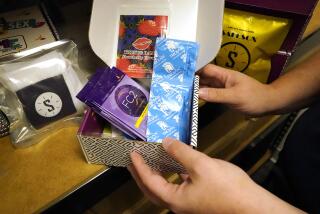Teen-Ager Alcohol Program Stresses Early Detection by Parents, Teachers
- Share via
WHITE PLAINS, N.Y. — Teachers and school administrators across America are at last grappling openly with the problem of teen-age alcohol and drug abuse, according to TARGET, an alcohol and drug education program created by the National Federation of State High School Assns.
Nearly 5 million adolescents, or three in 10, have a drinking problem, says Otis R. Bowen, secretary of health and human services. The National Council on Alcoholism reports that nearly a third of all high school seniors say most or all of their friends get drunk once a week.
As the youth crisis continues, more schools are working directly with treatment experts such as The Mediplex Group Inc., one of the first to offer schools an early detection program for substance abusers.
“Less than a decade ago, almost every school said this was another school’s problem,” said Barbara Ball, White Plains-based director of adolescent program development for Mediplex. “Finally, they’re openly admitting that chemical dependency is a major problem everywhere.”
Daily Contact With Youths
Substance abuse counselors say trained teachers and other school personnel are in a good position to effect change because of their daily contact with teen-agers. To help their students before it is too late, more educators are learning how to recognize the warning signs of teen-age alcohol abuse.
The Mediplex early-detection program, offered to schools at no charge, is designed to help build alcohol awareness among staff members.
The health-care company operates residential alcohol and drug treatment centers with teen programs in Shawnee, Kan.; Charlottesville, Va., and Spofford, N.H. It also has adolescent programs in the facilities it manages in Scotia, N.Y., and Carmel. Lake of the Ozarks, Mo., will have a teen program later this year.
“We spend about three hours teaching the entire school staff about alcoholism,” Ball said. “We want to take away the stigma of alcoholism and show that kids who get caught up in it aren’t ‘bad’ or from bad homes.”
After the presentation, five to seven faculty volunteers form a team that receives more in-depth alcohol education and training. If a student is behaving in a way that may signal alcohol abuse, the key team distributes confidential “behavior checklists” to all staff members--including the school bus driver--who see the teen daily.
‘A Broad Picture’ Sought
“The staff isn’t putting a label on the child but simply identifying specific, troublesome behavior,” said Art Sullivan, program director for adolescents at Mountain Wood, the Mediplex facility in Charlottesville. “By looking closely at all these checklists, the key team can get a broad picture of what’s going on with an individual teen-ager.”
If alcohol abuse is suspected, administrators contact the student’s parents, suggesting where the teen-ager can get a professional evaluation. The goal is to get teens who are problem drinkers--or already alcoholic--into treatment.
“If a teen is having a problem, it’s important to find out if alcoholism is behind it,” Ball said. “In the past, many kids were labeled emotionally disturbed or learning disabled when their real problem was alcoholism. As schools are becoming more educated, this is happening less.”
The early detection program is most commonly used in high schools, where alcohol problems tend to be most visible. But middle and junior high schools are also using the program successfully.
The NCA reports that most young people today try alcohol at age 12, compared to 13 or 14 just a few decades ago.
These are the warning signs that may indicate a youthful drinking problem, according to treatment professionals:
--- Uses home like a motel--a place to just eat and sleep.
--- Neglects hygiene suddenly.
--- Displays frequent mood swings and personality changes.
--- Loses interest in grades, which begin to drop.
--- Skips class or school for days at a time.
--- Changes to a different crowd of friends.
--- Withdraws from family, becoming secretive.
--- Sneaks money or liquor out of the house.
Ball notes that it is sometimes difficult to separate the real symptoms of a drinking problem from typical adolescent behavior.
“But if your child is experiencing most of these reactions at the same time, and the reactions are intense, he may be in trouble,” she said.
More to Read
Sign up for Essential California
The most important California stories and recommendations in your inbox every morning.
You may occasionally receive promotional content from the Los Angeles Times.













